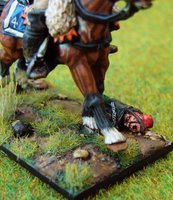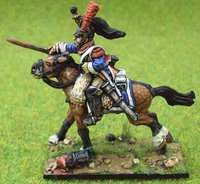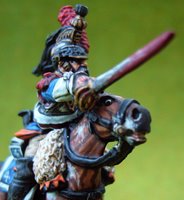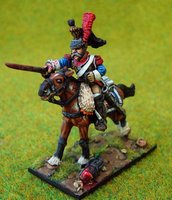Featuring Eureka 18mm Napoleonic French Infantry
I have just finished painting some 18mm Post-1812 Napoleonic French Infantry recently released by Eureka (superbly sculpted by Alan Marsh) - see release.
Here are a couple for now but check back soon as I'll be posting a load more pix of my first completed 18mm French battalion ~ 1e Battalion 72e Ligne Regiment ~ that fought at Quatre-Bras but here are a couple for now. Strangely enough, I found them as challenging to paint as 25-28mm figures basically because I am into fine detail - if only I could be less fussy.

And just in case you're all wondering what the hell those things are on thier bayonets...well, its a couple of loaves of bread and 2 shoulders of pork - hey an army needs to eat! Seriously, many soldiers marched with food suppliers skewered on their bayonets as they had no room to put it anywhere else. I have a line drawing of such an infantryman in an old book on the Imperial Guard if anyone is interested in my source. Anyway, nothing beats a dash of detail to complete the ensemble and as I've seen no other painter do such a thing, maybe I'll start a trend though I'm not sure how this battalion would fair in a bayonet charge against the Brits?
What I can say is they look pretty good from a distance but like my 28mm pix, I will allow you to scrutinise my paintwork close-up and in all their unflattering detail - so be kind, please!
I'll post a full article on Eureka's 18mm figures and more pix shortly and for those of you who wish to leave a comment or two, I've sorted my settings to allow anyone to comment.
JC
30 January 2006
COMING SOON - WORKBENCH #3
Posted by
JC - Painter of Miniatures
2
comments
![]()
29 January 2006
COMING SOON - French OOB at Quatre-Bras
Coming in February:
OOB for The Battle of Quatre-Bras, 16 June 1815
Part 1: French Army
I plan to post an extensively researched Order of Battle (OOB) for The Battle of Quatre-Bras. I have chosen this specific battle for two reasons, firstly as the title of my blog suggests, I am a fan of Napoleon’s 100 Days campaign and secondly, the number of troops present on the battlefield was far smaller than at Ligny or Waterloo and, lends itself to brigade level wargaming using my favourite Napoleonic rules set – David Brown’s General de Brigade (2nd Edition).
I am building opposing armies using the fabulous new 18mm Napoleonic range from Eureka Miniatures (Australia) and, where applicable, AB Miniatures 15mm Napoleonic range (NB: on 1st March 2006 Eureka Miniatures will become the sole World-Wide manufacturer of AB Figures’ 15mm Napoleonic, ACW and Ancients ranges - see release). As AB miniatures don't cover the 1815 period, my fingers are crossed that Eureka decide to add to their 1815 range!
In the meantime, here are a couple of sample pages from Part 1, the French OOB at The Battle of Quatre-Bras detailing basing guidelines for infantry battalions, artillery & cavalry regiments and commanders using GdeB rules set.
OOB Battle of Quatre-Bras - Part 1 French
Plate 3 French Command
Click on plate to view full-size image
OOB Battle of Quatre-Bras - Part 1 French
Plate 7 Imperial Guard - Light Cavalry Division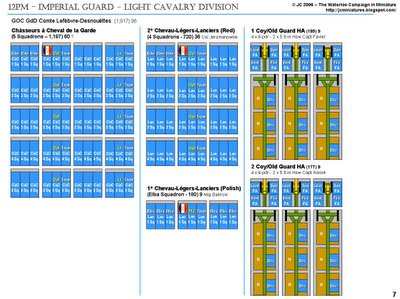
OOB Battle of Quatre-Bras - Part 1 French
Plate 8 II Corps - 9th Infantry Division
~ JOIN MY MAILING LIST ~ Those who wish to be informed of future postings, send me an email to jc_london@yahoo.com and and I will add you to my list of subscribers to The Waterloo Campaign in Miniature.
Posted by
JC - Painter of Miniatures
0
comments
![]()
WORKBENCH #2 - 28mm Old & Middle Guard (Foundry)
Here are some other 28mm Foundry Napoleonic miniatures that I painted last December. I took these photos using natural sunlight under a glass-roof conservatory. I used my trusty Panasonic Lumix 4.0 Mega Pixel digital camera (Model DMC-LS1EB) with the following settings:
Digital Camera Settings:
Mode: Macro - allows you to take close-up photos of the figure
White Balance: Auto (I use a green felt background so white balance is set to auto)
ISO Sensitivity: 200
Picture Size: 2304 (2304 x 1728 pixels)
Quality: Fine (Low compression)
AF Mode: Spot-focusing (The camera focuses on the limited and narrow area on the screen)
Slow Shutter: - ½ or 1 depending on light quality
Drummer, 1e Bn. 1e Grenadiers à Pied, Old Guard (1815)
Manufacturer: Foundry
Product code: FN152 Imperial Guard Grenadiers Campaign Dress Command
Painter: JC (December 2005)


Grenadier, 1e Bn. 3eme Grenadiers à Pieds, Middle Guard (1815)
Manufacturer: Foundry
Product code: Unavailable
Painter: JC (December 2005)


Sous-Lieutenant, 1e Bn. 3eme Grenadiers à Pieds, Middle Guard (1815)
Manufacturer: Foundry
Product code: FN152 Imperial Guard Grenadiers Campaign Dress Command
Painter: JC (December 2005)


Lieutenant, 1e Bn. 3eme Grenadiers à Pieds, Middle Guard (1815)
Manufacturer: Foundry
Product code: FN152 Imperial Guard Grenadiers Campaign Dress Command
Painter: JC (December 2005)
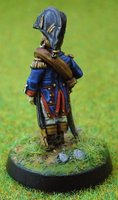
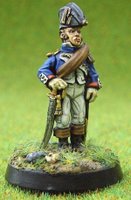
Premier Porte-Aigle, 1e Bn. 1eme Grenadiers à Pieds, Old Guard (1815)
Manufacturer: Foundry
Product code: FN152 Imperial Guard Grenadiers Campaign Dress Command
Painter: JC (December 2005)
I've used a rolled-up standard here topped by an eagle from Old Glory
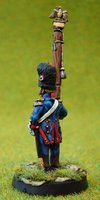

Premier Porte-Aigle, 1e Bn. 1eme Grenadiers à Pieds, Old Guard (1815)
Manufacturer: Foundry
Product code: FN165 Imperial Guard Grenadiers Greatcoat Marching
Painter: JC (December 2005)
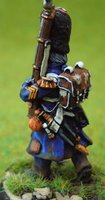

Please post your comments below or send me an email to jc_london@yahoo.com
NEXT POST: WORKBENCH #3 - 18mm French Napoleonic from Eureka
Posted by
JC - Painter of Miniatures
1 comments
![]()
28 January 2006
WORKBENCH #1 - 28mm Cuirassier (Foundry)
Since visiting Salute Zero Five last April (2005), I’ve spent most of my free time learning the art of painting miniatures from 10mm to 40mm and after many months of trial and error (and error), believe I’m ready to show my work offering some tips and advice along the way.
In WORKBENCH #1, I have featured a French Napoleonic Cuirassier from Foundry, in my view one of the best manufacturers of 28mm miniatures around. This figure is a trooper from the 4th Cuirassier Regiment, attached to the 13th Cavalry Division of Napoleon's Armée du Nord that took part in the massed cavalry charge at 3.30pm on 18th June 1815 at The Battle of Waterloo and one that makes me particularly proud.
Here's a brief description of how I acheived the finished result.
Step 1: Preparing the Figure
Firstly I removed all the excess metal (often referred to as Flash) from the figure, which in the case of all Foundry miniatures is fairly negligible. To do this I used a scalpel and small file to smooth down any uneven bumps. Then I applied an undercoat of Humbrol Matt Black (Matt 33) slightly diluted with thinner in order not to lose definition.
Step 2: Painting Stage
To paint the figure, I sourced the best reference material around – vital if you want to attain accuracy. In this case, and for other avid fans of the Napoleonic era, check out my “Uniform links” – possibly the best examples of Napoleonic uniforms on the web. Unlike most professional painters who recommend Foundry or Vallejo paints, I use paints from the Games Workshop, which seem to do a good enough job for me. The main reason being there’s a shop close by! As for a paint brush, I have tried many and am generally never satisfied. My current preference is the 2/0 Pro Arte Prolene brush. My painting method is an amalgam of my own style (which is still evolving) coupled with the painting tips from some of the best painters around (see my links) and months of hard practice. (I will post an article that will deal with PAINTING TECHNIQUES in the near future). In brief, I generally use three different shades of the same colour to achieve tone and shading by applying a base coat (the darkest shade), a mid-tone and finally a highlight painted inside the mid-tone (i.e. the lightest version of the same colour).
Painting Horses
This is not to be undertaken for the fainthearted. Again I must recommend a brilliant web site that I found – Horse Power Graphics Inc (USA) that provides an amazing resource of beautifully painted horses for reference. Click on Painted Horse Gallery to view examples. I will also post a step-by-step guide to painting horses (with pix) in the near future. UPDATE: The Horses Eyes - To get the mcrazed look, I simply painted a blob of black in the centre of the white of the horses eye making sure that the black didn't touch any part of the eyelid - hey presto - one crazed manic horse!
Step 3: Varnishing
Once I’d finished painting the figure, I applied a coat of Humbrol clear gloss varnish (Gloss 35) and left to dry for 24 hours before applying a coat of Blackfriars Clear Varnish Matt P101 – simply the best varnish around. Warning: Do be very careful when using this matt varnish as you can’t use it straight away. You must leave it for at least one month upside down to allow thick goop to separate and settle on the underside of the lid. Then mix this goop with thinner and paint it on a spare painted figure to check you have the right consistency…and when you do, the result is awesome!
Step 4: Basing
I used a 2mm thick black plastic sheet that you can get from any modelling shop and cut it to the required size. I then used Airclay – air drying modelling clay reinforced with nylon fibres for extra strength, which I applied to the base using a tooth pick to press down and sculpt accordingly. Once dry, I painted patches of PVA glue to the base and then covered with fine sand before applying paint… and just in case you were wondering, the severed head is from a decapitated 25mm Old Glory British Napoleonic infantryman (Light Company)… and YES, I do love applying detail.
UPDATE: The Decapitated Head
28 January 2006
Here are some other pix of the Cuirassier showing a bit of the detail I so enjoy. The photos were taken by me using a Panasonic Lumix 4.0 Mega Pixel digital camera (Camera settings: Macro / White Balance - Auto / Sensitivity - 200ASA / Picture Size - 2304 / Quality - Fine / AF Mode - Fine / Slow Shutter -0.5 (minus half) / Picture - Vivid).
[Click on the photo to view full-size image].
COMMENTS: I welcome all comments.
Posted by
JC - Painter of Miniatures
1 comments
![]()
27 January 2006
A Passion Rekindled – I SALUTE You!
I happened to be walking past Olympia in Hammersmith last year and couldn’t help but notice a queue more commonly seen at a Rolling Stones concert. On closer inspection, it was for Salute Zero Five, one of the premier exhibitions for wargaming enthusiasts. As a military modelling devotee in my youth and an avid visitor of the once famous Military Modelling Exhibition at the Wembley Conference Centre back in the late 70’s, I felt impelled to buy a ticket on spec and take a look for myself.
Hosted by one of the UK’s foremost wargames clubs, South London Warlords under the inspiring tutelage of club president John Treadway, I found myself instantly reliving the heady days of my childhood as an amateur wargaming enthusiast and keen painter of Hinchliffe 25mm Napoleonic miniatures.
From the moment I walked through Olympia’s doors and took in the vast array of exhibitors’ stands, displays and wargames on show, I felt a rush of excitement and the rekindling of a pastime that I thought was lost for good. Salute has something for everyone covering every genre of wargaming imaginable – from historical to Sci-Fi, and for the uninitiated and those Dads out there desperate to extract their children from the constant lure of computer gaming, here’s an opportunity to fire their imagination and see some of the best exponents of wargaming and military modelling in the UK if not Europe.
Like a kid sweet shop, my eyes darted from one enticing display to another. What struck me immediately was the quality of craftsmanship on show. As a fan of anything Napoleonic, I found myself feasting my eyes on exquisitely painted miniatures of all sizes from 6mm to 70mm and I’ll challenge anyone not be tantalised at the quality of sculpting and paintwork. Before I knew it, 6 hours had gone by and with tiring legs; I left the show with a bag of unpainted 28mm Napoleonic miniatures and a passion rekindled!
For those interested in this years Salute Zero Six on 22nd April at ExCel, Royal Victoria Docks click on the banner.
....and so here I am, 10 months later and at the beginning of a new year, ready to embark on recreating a battle - THE BATTLE OF QUATRES BRAS!
JC
Posted by
JC - Painter of Miniatures
1 comments
![]()



